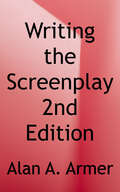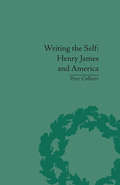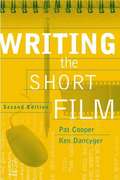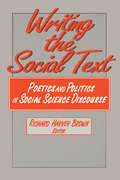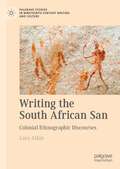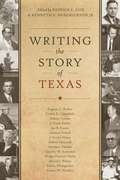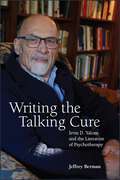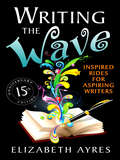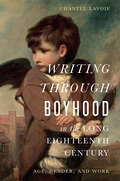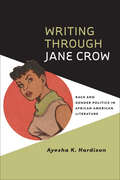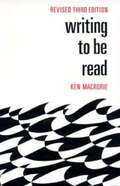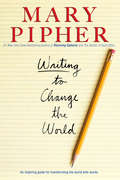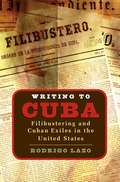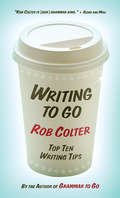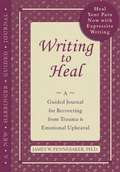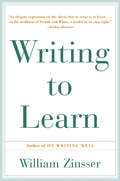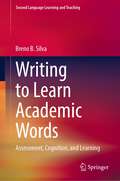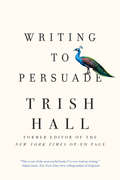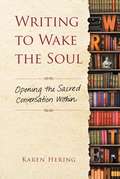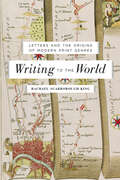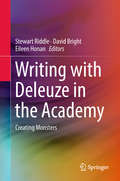- Table View
- List View
Writing the Screenplay: TV and Film
by Alan A. ArmerIn this new edition, Emmy - Award winner Alan Armer takes aspiring writers through the essential steps needed to create successful dramatic scripts for TV and Film: visual thinking characters and plotting, story structure and conflict, dialog, and formats.
Writing the Self: Henry James and America
by Peter CollisterA monograph that re-evaluates the final decade of Henry James' creative life. It examines the narrative of "The American Scene", the autobiographical writing, a number of short stories and two incomplete novels: works which offer contrasting notations of the self.
Writing the Short Film (second edition)
by Ken Dancyger Pat CooperWriters who want to write a fil will find this to be a useful book. The usefulness of this book goes beyond the writing or filmmaking class.
Writing the Social Text: Poetics and Politics in Social Science Discourse
by Richard BrownDuring the past decade, it has become commonplace to interpret social and cultural reality-the very groundwork of the social sciences-as linguistic constructions. Not only is society viewed as a text, but scientific texts themselves are seen as rhetorical constructions. This collection of scholarly essays begins with an overview of this emerging field, and covers the specific stylistic practices by which social scientists create -objective- or -true- representations of society. The volume closes with a consideration of the more telling challenges to the rhetorics of the social sciences and how these might be encompassed or overcome.
Writing the South African San: Colonial Ethnographic Discourses (Palgrave Studies in Nineteenth-Century Writing and Culture)
by Lara AtkinThis book offers an innovative new framework for reading British and settler representations of Indigenous peoples in the nineteenth century. Taking the representation of the Southern African San as its case study, it uses methodologies drawn from critical anthropology, imperial history and literary studies to show the role that literary representations of Indigenous peoples played in popularising the hierarchical view of racial difference. The study identifies an ‘ethnographic poetics’ in which the claims of scientific discourse blend with a consciously literary preference for metaphor and analogy. This created a set of mobile figures that could be disseminated to different reading publics in both Britain and the colonies through a variety of literary genres and textual media. It advances research on race and imperial history by focusing on the importance of literature - from newspapers and periodicals to popular novels - in shaping discourses of national and racial belonging in Britain and the Cape Colony.
Writing the Story of Texas
by Patrick L. Cox Kenneth E. Hendrickson Jr.The history of the Lone Star state is a narrative dominated by larger-than-life personalities and often-contentious legends, presenting interesting challenges for historians. Perhaps for this reason, Texas has produced a cadre of revered historians who have had a significant impact on the preservation (some would argue creation) of our state's past. An anthology of biographical essays, Writing the Story of Texas pays tribute to the scholars who shaped our understanding of Texas's past and, ultimately, the Texan identity. Edited by esteemed historians Patrick Cox and Kenneth Hendrickson, this collection includes insightful, cross-generational examinations of pivotal individuals who interpreted our history. On these pages, the contributors chart the progression from Eugene C. Barker's groundbreaking research to his public confrontations with Texas political leaders and his fellow historians. They look at Walter Prescott Webb's fundamental, innovative vision as a promoter of the past and Ruthe Winegarten's efforts to shine the spotlight on minorities and women who made history across the state. Other essayists explore Llerena Friend delving into an ambitious study of Sam Houston, Charles Ramsdell courageously addressing delicate issues such as racism and launching his controversial examination of Reconstruction in Texas, Robert Cotner-an Ohio-born product of the Ivy League-bringing a fresh perspective to the field, and Robert Maxwell engaged in early work in environmental history.
Writing the Talking Cure: Irvin D. Yalom and the Literature of Psychotherapy
by Jeffrey BermanA distinguished psychiatrist and psychotherapist, Irvin D. Yalom is also the United States' most well-known author of psychotherapy tales. His first volume of essays, Love's Executioner, became an immediate best seller, and his first novel, When Nietzsche Wept, continues to enjoy critical and popular success. Yalom has created a subgenre of literature, the "therapy story," where the therapist learns as much as, if not more than, the patient; where therapy never proceeds as expected; and where the therapist's apparent failure provesultimately to be a success.Writing the Talking Cure is the first book to explore all of Yalom's major writings. Taking an interdisciplinary approach, Jeffrey Berman comments on Yalom's profound contributions to psychotherapy and literature and emphasizes the recurrent ideas that unify his writings: the importance of the therapeutic relationship, therapist transparency, here-and-now therapy, the prevalence of death anxiety, reciprocal healing, and the idea of the wounded healer. Throughout, Berman discusses what Yalom can teach therapists in particular and the common (and uncommon) reader in general.
Writing the Wave: Inspired Rides for Aspiring Writers
by Elizabeth AyresWhere's your wave of creativity? If you want to learn how to write, "Writing the Wave: Inspired Rides for Aspiring Writers" is the very first writing book designed especially for beginning writers who yearn to write more expressively. Written with warmth and wit by internationally acclaimed writer and teacher Elizabeth Ayres, this 15th anniversary edition of a classic writing how-to book makes the creative process safe, easy and fun while honoring its spiritual depth and mystery. Elizabeth shows you how it's done. With step-by-step instructions and easy-to-follow writing exercises, you'll be writing non-stop from the very first page, even if you've never written before. It's just like having a personal writing coach. You can learn how to be a writer. Throw away those endless lists of writing prompts. Learn how to discover your own ideas with these break-through writing exercises that transform fundamental writing principles into concrete writing techniques you can use over and over, forever, whether you want to learn how to write fiction, nonfiction, poetry -- or something that doesn't even have a name yet. Unlike other writing books, "Writing the Wave" couples inspiring writing exercises with expert and compassionate advice, to minimize the fears and maximize the joys of writing. And more advanced writers looking for a jumpstart will appreciate recovering their free-flowing creative wellspring. There's a vast ocean of inspiration within you. The surf's up! The water's warm! Are you ready to take the plunge? "Elizabeth Ayres has thought long and hard about the writing process, and is one of the most seasoned and exemplary practitioners in the field of teaching writing. This book about writing is an invaluable distillation of her insights and experiences. I cannot imagine any beginning or struggling writer not coming away with some inspiration from it." (Phillip Lopate, editor of "The Art of Writing" and "Writing New York")
Writing the West, 1750-1947: Representations from Indian Languages
by C. VijayasreeContributed papers presented at a national seminar organized by Sahitya Akademi held at Madurai, 2001.
Writing through Boyhood in the Long Eighteenth Century: Age, Gender, and Work
by Chantel LavoieWriting through Boyhood in the Long Eighteenth Century explores how boyhood was constructed in different creative spaces that reflected the lived experience of young boys through the long eighteenth century—not simply in children’s literature but in novels, poetry, medical advice, criminal broadsides, and automaton exhibitions. The chapters encompass such rituals as breeching, learning to read and write, and going to school. They also consider the lives of boys such as chimney sweeps and convicted criminals, whose bodily labor was considered their only value and who often did not live beyond boyhood. Defined by a variety of tasks, expectations, and objectifications, boys—real, imagined, and sometimes both—were subject to the control of their elders and were used as tools in the cause of civil society, commerce, and empire. This book argues that boys in the long eighteenth century constituted a particular kind of currency, both valuable and expendable—valuable because of gender, expendable because of youth.
Writing through Jane Crow: Race and Gender Politics in African American Literature
by Ayesha K. HardisonIn Writing through Jane Crow, Ayesha Hardison examines African American literature and its representation of black women during the pivotal but frequently overlooked decades of the 1940s and 1950s. At the height of Jim Crow racial segregation—a time of transition between the Harlem Renaissance and the Black Arts movement and between World War II and the modern civil rights movement—black writers also addressed the effects of "Jane Crow," the interconnected racial, gender, and sexual oppression that black women experienced. Hardison maps the contours of this literary moment with the understudied works of well-known writers like Gwendolyn Brooks, Zora Neale Hurston, Ann Petry, and Richard Wright as well as the writings of neglected figures like Curtis Lucas, Pauli Murray, and Era Bell Thompson.By shifting her focus from the canonical works of male writers who dominated the period, the author recovers the work of black women writers. Hardison shows how their texts anticipated the renaissance of black women’s writing in later decades and initiates new conversations on the representation of women in texts by black male writers. She draws on a rich collection of memoirs, music, etiquette guides, and comics to further reveal the texture and tensions of the era.A 2014 CHOICE Outstanding Academic Title
Writing to Be Read (Revised Third Edition)
by Ken MacrorieThis book intends to give a thorough writing course to students that will help them express themselves efficiently.
Writing to Change the World
by Mary PipherFrom the #1 New York Times bestselling author of Reviving Ophelia, Another Country, and The Shelter of Each Other comes an inspirational book that shows how words can change the world. Words are the most powerful tools at our disposal. With them, writers have saved lives and taken them, brought justice and confounded it, started wars and ended them. Writers can change the way we think and transform our definitions of right and wrong. Writing to Change the World is a beautiful paean to the transformative power of words. Encapsulating Mary Pipher's years as a writer and therapist, it features rousing commentary, personal anecdotes, memorable quotations, and stories of writers who have helped reshape society. It is a book that will shake up readers' beliefs, expand their minds, and possibly even inspire them to make their own mark on the world. .
Writing to Cuba
by Rodrigo LazoIn the mid-nineteenth century, some of Cuba's most influential writers settled in U.S. cities and published a variety of newspapers, pamphlets, and books. Collaborating with military movements known as filibusters, this generation of exiled writers created a body of literature demanding Cuban independence from Spain and alliance with or annexation to the United States. Drawing from rare materials archived in the United States and Havana, Rodrigo Lazo offers new readings of works by writers such as Cirilo Villaverde, Juan Clemente Zenea, Pedro Santacilia, and Miguel T. Tolon. Lazo argues that to understand these writers and their publications, we must move beyond nation-based models of literary study and consider their connections to both Cuba and the United States. Anchored by the publication of Spanish- and English-language newspapers in the United States, the transnational culture of writers Lazo calls los filibusteros went hand in hand with a long-standing economic flow between the countries and was spurred on by the writers' belief in the American promise of freedom and the hemispheric ambitions of the expansionist U.S. government. Analyzing how U.S. politicians, journalists, and novelists debated the future of Cuba, Lazo argues that the war of words carried out in Cuban-U.S. print culture played a significant role in developing nineteenth-century conceptions of territory, colonialism, and citizenship.
Writing to Go: Top Ten Writing Tips
by Rob ColterIn today's fast-paced world of e-mail and instant messaging, clear writing is more important than ever. In Writing to Go, bestselling author Rob Colter takes us through the writing process in ten easy steps. This book is packed with precise and practical information delivered in a down-to-earth tone with often humorous examples. Everywhere from the classroom to the office, Colter's Top Ten Writing Tips will give you the confidence to write with greater speed and impact, covering everything from knowing your purpose and audience, to selecting your format, organizing your points, and writing clearly and effectively.
Writing to Heal: A Guided Journal for Recovering from Trauma and Emotional Upheaval
by James W. PennebakerThis book takes readers through a series of guided writing exercises that help them explore their feelings about difficult experiences. Each chapter begins with an introduction that explains how to proceed with journal exercises and what they are structured to help accomplish. The exercises leave readers with a strong sense of their value in the world.
Writing to Learn
by William ZinsserThis is an essential book for everyone who wants to write clearly about any subject and use writing as a means of learning.
Writing to Learn Academic Words: Assessment, Cognition, and Learning (Second Language Learning and Teaching)
by Breno B. SilvaThis book highlights the importance of English academic vocabulary for success at university and explores written tasks as effective pedagogical tools to promote the acquisition of academic words. The book reviews germane and recent SLA, psycholinguistic, corpus linguistics, and L2 writing research to underscore the challenges associated with the learning of academic words. Then, it reports on three empirical studies conducted in the Polish context. The first study develops a reliable tool to assess the knowledge of academic vocabulary of undergraduate learners. The second and third studies investigate the learning of academic words after the writing of sentences and argumentative essays, and discuss the role of cognition as a mediator of such learning. The book also provides an accessible introduction to linear mixed-effect models, a powerful, reliable, and flexible statistical technique that has been gaining popularity among SLA and psycholinguistics researchers.
Writing to Persuade: How To Bring People Over To Your Side
by Trish HallFrom the former New York Times Op-Ed page editor, a definitive and entertaining resource for writers of every stripe on the neglected art of persuasion. From the former New York Times Op-Ed page editor, a definitive and entertaining resource for writers of every stripe on the neglected art of persuasion. In the tradition of The Elements of Style comes Trish Hall’s essential new work on writing well—a sparkling instructional guide to persuading (almost) anyone, on (nearly) anything. As the person in charge of the Op-Ed page for the New York Times, Hall spent years immersed in argument, passion, and trendsetting ideas—but also in tangled sentences, migraine-inducing jargon, and dull-as-dishwater writing. Drawing on her vast experience editing everyone from Nobel Prize winners and global strongmen (Putin) to first-time pundits (Angelina Jolie), Hall presents the ultimate guide to writing persuasively for students, job applicants, and rookie authors looking to get published. She sets out the core principles for connecting with readers—laid out in illuminating chapters such as “Cultivate Empathy,” “Abandon Jargon,” and “Prune Ruthlessly.” Combining boisterous anecdotes with practical advice (relayed in “tracked changes” bubbles), Hall offers an infinitely accessible primer on the art of effectively communicating above the digital noise of the twenty-first century.
Writing to Wake the Soul
by Karen HeringThrough the power of everyday words, find and deepen your connection with faith and self in the spiritual practice of writing. Have you ever sought to wake that still, small voice within--the voice that gives expression to your greatest hopes, fears, dreams, and sorrows? Through the intersection of poetry and story, metaphor and mediation, history and culture, you have the power to. Perfect for today's spiritual seeker, Writing to Wake the Soul provides inspiration, practical guidance, and content-rich prompts to help you articulate and explore the difficult questions of our time. Its elegant narrative invites you to use words as a way to journey into a greater intimacy with your faith, your soul, and your relationship to the world. Whether you're a theist or atheist, agnostic or church-goer, accomplished writer or even a non-writer, this guide offers a thoughtful reflection on the enormous transformative power of words in our everyday lives. Featuring exercises for meditation, contemplation, and gentle self-examination, along with writing prompts on a wide spectrum of theological themes and spiritual practices, Writing to Wake the Soul will help you develop a greater connection to that voice, to the inner self, and to the timeless wisdom deep within you.
Writing to Win: The Legal Writer
by Steven D. StarkFrom a master teacher, a results-oriented approach to powerful legal writing that communicates, that persuades--and that wins.Of all the professions, the law has the most deserved reputation for opaque, jargon-clogged writing. Legal education, which focuses on judicial opinions, not instruments of persuasion, is partly to blame. Yet forceful writing is one of the most potent weapons of legal advocacy. In Writing to Win, Steve Stark, a former teacher of writing at Harvard Law, who has taught thousands of aspiring and practicing lawyers, has written the only book on the market that applies the universal principles of vigorous prose to the job of making a case--and winning it.Writing to Win focuses on the writing of lawyers, not judges, and includes dozens of examples of effective (and ineffective) real-life writing--as well as models drawn from advertising, journalism, and fiction. It deals with the problems lawyers face in writing, from organization to strengthening and editing prose; teaches ways of improving arguments; addresses litigation and technical writing in all its forms; and covers the writing attorneys must perform in their practice, from memos and letters to briefs and contracts. Each chapter opens with a succinct set of rules for easy reference.No other legal writing book on the market is as practical, as focused on results, as well written as Writing to Win.From the Trade Paperback edition.
Writing to the World: Letters and the Origins of Modern Print Genres
by Rachael Scarborough KingLetters played a foundational role in facilitating the rise of print and popularizing new modes of writing in the long eighteenth century.In Writing to the World, Rachael Scarborough King examines the shift from manuscript to print media culture in the long eighteenth century. She introduces the concept of the "bridge genre," which enables such change by transferring existing textual conventions to emerging modes of composition and circulation. She draws on this concept to reveal how four crucial genres that emerged during this time—the newspaper, the periodical, the novel, and the biography—were united by their reliance on letters to accustom readers to these new forms of print media.King explains that as newspapers, scientific journals, book reviews, and other new genres began to circulate widely, much of their form and content was borrowed from letters, allowing for easier access to these unfamiliar modes of printing and reading texts. Arguing that bridge genres encouraged people to see themselves as connected by networks of communication—as members of what they called "the world" of writing—King combines techniques of genre theory with archival research and literary interpretation, analyzing canonical works such as Addison and Steele’s Spectator, Samuel Johnson’s Lives of the Poets, and Jane Austen’s Northanger Abbey alongside anonymous periodicals and the letters of middle-class housewives. This original and groundbreaking work in media and literary history offers a model for the process of genre formation. Ultimately, Writing to the World is a sophisticated look at the intersection of print and the public sphere.
Writing to the World: Letters and the Origins of Modern Print Genres
by Rachael Scarborough King“King’s pitch for the indebtedness of the genres we know well—the novel, the biography, the magazine piece—to letter writing is stylish and convincing.” —Christina Lupton, author of Reading and the Making of Time in the Eighteenth CenturyIn Writing to the World, Rachael Scarborough King examines the shift from manuscript to print media culture in the long eighteenth century. She introduces the concept of the “bridge genre,” which enables such change by transferring existing textual conventions to emerging modes of composition and circulation. She draws on this concept to reveal how four crucial genres that emerged during this time—the newspaper, the periodical, the novel, and the biography—were united by their reliance on letters to accustom readers to these new forms of print media.King explains that as newspapers, scientific journals, book reviews, and other new genres began to circulate widely, much of their form and content was borrowed from letters, allowing for easier access to these unfamiliar modes of printing and reading texts. Arguing that bridge genres encouraged people to see themselves as connected by networks of communication—as members of what they called “the world” of writing—King combines techniques of genre theory with archival research and literary interpretation, analyzing canonical works such as Addison and Steele’s Spectator, Samuel Johnson’s Lives of the Poets, and Jane Austen’s Northanger Abbey alongside anonymous periodicals and the letters of middle-class housewives.This original and groundbreaking work in media and literary history offers a model for the process of genre formation. Ultimately, Writing to the World is a sophisticated look at the intersection of print and the public sphere.“This erudite, sophisticated, beautifully written book is a major achievement.” —Thomas Keymer, author of Poetics of the Pillory
Writing with Confidence: Writing Effective Sentences and Paragraphs
by Alan MeyersWriting With Confidence, a value-priced developmental writing book, provides essential instruction and practice in basic writing skills at the sentence and paragraph level. The first developmental book to include incorporate high-interest, connected discourse subject matter in its exercises,Writing with Confidenceretains and expands on this feature. Most chapters pursue a theme throughout the exercises-the dreams and premonitions surrounding the death of Abraham Lincoln; animal facts and oddities; the gustatory achievements of Diamond Jim Brady, the world's greatest eater; the voyage of the Kon-Tiki; and so on. The text's six-unit structure includes thirty short chapters on the writing process, paragraph organization and development, the shape of the essay, all the rhetorical modes, and all the sentence skills. The writing chapters are fully process oriented, showing the development of a paragraph in six steps, from planning and outlining through drafting, revising, editing, and proofreading. Optional collaborative activities are provided in the margins of each chapter. This focus on writing is balanced with equal attention to sentence skills, not only for native speakers of English who need help, but for non-English-dominant speakers as well. ESL boxes provide help for readers whose first language is not English, as do the two final chapters of the book, which address troublesome matters such as verb phrases, word order, articles, and prepositions. The reading-writing connection throughout the book has been expanded, with sixteen additional readings in the last unit of the book. And the popular "Blueprints for Writing" found in the rhetorical chapters have been carried into unit ending "Blueprints for Success," in which the most important concepts and practices are summarized in graphs and charts. For those seeking to develop their writing skills at the sentence to paragraph level.
Writing with Deleuze in the Academy: Creating Monsters
by Stewart Riddle David Bright Eileen HonanIn this book, authors working with Deleuzean theories in educational research in Australia and the United Kingdom grapple with how the academic-writing machine might become less contained and bounded, and instead be used to free impulses to generate different creations and connections. The authors experiment with forms of writing that challenge the boundaries of academic language, moving beyond the strictures of the scientific method that governs and controls what works and what counts to make language vibrate with a new intensity.The authors construct monstrous creations, full of vitality and fervor, hybrid texts, part academic part creative assemblages, almost-but-perhaps-not-quite recognisable as research. Stories that blur the lines between true and untrue, re-presentation and invention.The contributors to this book hope that something might happen in its reading; that some new connections might be made, but also acknowledge the contingency of the encounter between text and reader, and the impossibility of presuming to know what may be.
